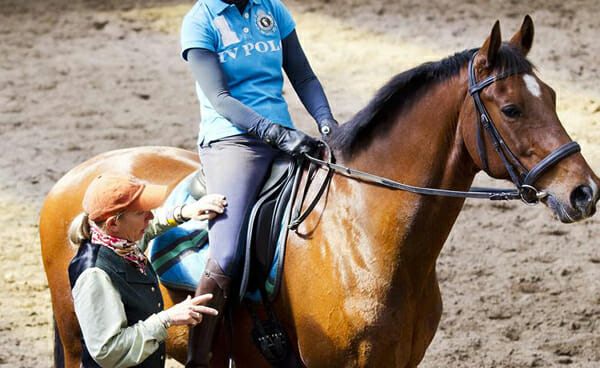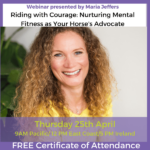FINDING GOOD THIGH CONTACT
Do you have trouble getting your horse to go forward? Do you bump or hit the front of your saddle with your pelvis? Do you feel insecure over the fences? The answer may be caused by not having good thigh contact with your horse and saddle.
Next time your ride pay attention to your thighs. Are they close to the saddle? Could someone slide their hand between your thigh and the saddle without gapping or pinching? How much muscular effort are you aware of in your thighs? Do you feel like you have to “hold” your leg in place? Does it feel like your thigh is being “pushed” out by the saddle? Take a moment to assess how your saddle fit fits you.
DOES YOUR SADDLE FIT PROPERLY?
Your saddle has a tremendous influence on the way your thigh rests. If the flap is too short, the knee rolls are incorrectly placed or the seat is too wide (as in some tree-less saddles) you will have difficulty getting your thigh to lie flat on your horse’s sides. If the saddle is too big, the stirrup bars or fenders are placed too far forward or you are riding with a hollow back you might tend to grip with your thighs in an attempt to feel secure.
Your saddle needs to accommodate the length of your thigh. For more information on saddle fit I highly recommend “The Pain Free Back and Saddle Fit Book” by Dr. Joyce Harman. While this book is geared towards English saddles, 40% of the information applies to western saddles and riders.
In her book, Dr. Harman discusses the key to correctly fitting the rider. Correct seat size is determined by your thigh length not your buttocks. In addition, the ground seat or twist of the saddle needs to match your pelvic shape to free your hip offering you a comfortable leg position. Whatever the cause, riding with a thigh pinched in or turned out makes riding harder for both you and your horse.
DISTRIBUTING YOUR WEIGHT
When your leg lies flat along your horse’s sides your weight is distributed over the area of your thighs and pelvis. This increased surface area decreases pressure in any one place. Think of a broad firm hug vs. being poked in the back. You want your weight distributed down through your thighs along the horse’s sides, not just pressing down on his back.
Riding with your knees turned out places most of your weight directly on the horse’s back. This leg position will not distribute weight along the horse’s sides. Standing in the stirrups or posting the trot with your knees turned out puts all your weight in the stirrups, which through the fenders or stirrup bars is concentrated on the horse’s back.
Knee pinching again minimizes the surface area over which your weight is distributed and takes a lot of muscular effort. Gripping will restrict your ability to follow the horse’s motion and can restrict the horse’s breathing since you are essentially squeezing the horse’s ribcage. Imagine what would be like to have someone constantly giving you strong hug. Knee pinching also creates a point around which you can pivot thus the reason for feeling very insecure over fences.

Above left: Knee turned out. Now the rider’s weight is only on her seat with no thigh support. This will restrict the rider’s ability to follow the horse’s movement and the horse from freely moving forward.
Above center:. Gripping with the thigh. A too-tight thigh will also block the horse’s movement and the rider’s seat while creating a pivot point, making the rider unstable.
Above right:: Good thigh position. Notice the even contact of the thigh with the saddle, without gapping or pinching. This provides good weight distribution and support for the rider and allows her seat to follow the motion of the horse.
SO WHERE SHOULD YOUR THIGH BE?
When the thigh lies flat on the saddle the femur or thighbone becomes the structural support for the stability minimizing the amount of muscular effort needed to be adhesive and adherent with the saddle and horse.
Use this tip as a ‘body position self-check’. An even contact with the thigh gives you more stability with less muscular effort. Your weight will be distributed over a larger surface area making it more comfortable for your horse. If you find you are having difficulty achieving this position, check your saddle fit and remember – enjoy the ride!
If you enjoyed this post, you might also like:
A 5-video series on rider balance and posture presented by Wendy Murdoch, which is available here to everyone signed up to the Equitopia membership program.
The Essential Guide to Saddle Fit Video Course which explains what you need to know about English saddles, how they should fit you and your horse, how to tell when your saddle may be causing a problem and what you should do about it.




